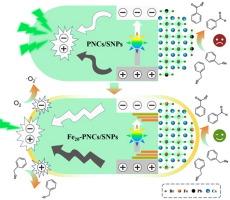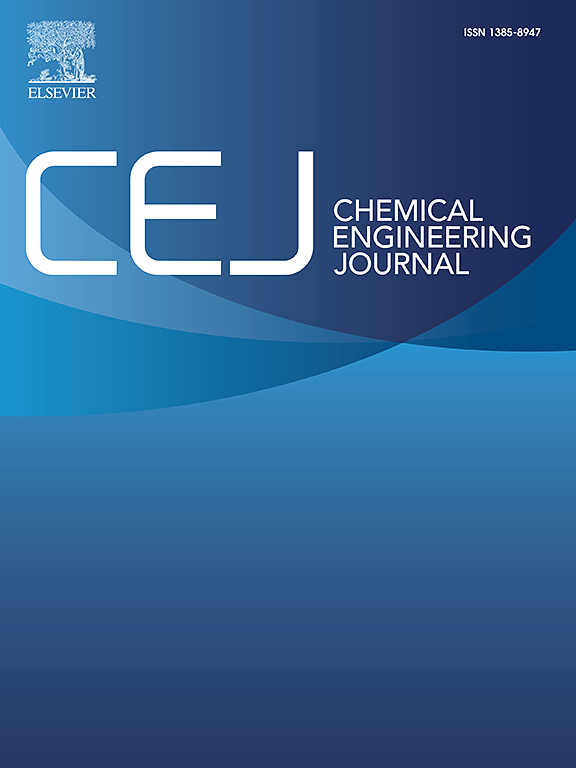Efficient and selective photocatalytic oxidation of benzylic alcohols with built-in electric field CsPbBr3/SiO2 nanocomposites through Fe3+ gradient doping
IF 13.3
1区 工程技术
Q1 ENGINEERING, CHEMICAL
引用次数: 0
Abstract
Lead halide perovskite nanocrystals (PNCs) have emerged as promising materials for photocatalysis due to their exceptional optoelectronic properties, yet achieving efficient charge separation and selective oxidation reactions remains a significant challenge. In this study, we report the synthesis of Fe3+-doped CsPbBr3/SiO2 nanocomposites (Fe-PNCs/SNPs) with gradient energy levels, designed to enhance photocatalytic performance. Our results demonstrate that Fe3+ doping introduces mid-gap states, promotes photoinduced charge separation, and generates reactive oxygen species (ROS) such as O2− and
O2− and  OH radicals under sunlight-simulating light irradiation from a 300 W Xe arc lamp. The Fe20-PNCs/SNPs catalyst achieved over 99 % conversion of benzyl alcohol to benzaldehyde with high selectivity and stability in the ethanol under ambient conditions. Additionally, the catalyst exhibited excellent recyclability and broad substrate tolerance. These findings highlight the innovative design of gradient energy levels in perovskite nanocomposites, offering a new strategy for enhancing photocatalytic efficiency in selective organic transformations.
OH radicals under sunlight-simulating light irradiation from a 300 W Xe arc lamp. The Fe20-PNCs/SNPs catalyst achieved over 99 % conversion of benzyl alcohol to benzaldehyde with high selectivity and stability in the ethanol under ambient conditions. Additionally, the catalyst exhibited excellent recyclability and broad substrate tolerance. These findings highlight the innovative design of gradient energy levels in perovskite nanocomposites, offering a new strategy for enhancing photocatalytic efficiency in selective organic transformations.

通过掺杂 Fe3+ 梯度,利用内置电场 CsPbBr3/SiO2 纳米复合材料高效、选择性地光催化氧化苯甲醇
卤化铅过氧化物纳米晶体(PNCs)因其卓越的光电特性而成为一种前景广阔的光催化材料,然而实现高效的电荷分离和选择性氧化反应仍然是一项重大挑战。在本研究中,我们报告了具有梯度能级的 Fe3+ 掺杂 CsPbBr3/SiO2 纳米复合材料(Fe-PNCs/SNPs)的合成,旨在提高光催化性能。我们的研究结果表明,在 300 W Xe 弧光灯的模拟太阳光照射下,Fe3+ 掺杂引入了中隙态,促进了光诱导的电荷分离,并产生了活性氧(ROS),如 O2- 和 OH 自由基。在环境条件下,Fe20-PNCs/SNPs 催化剂在乙醇中将苯甲醇转化为苯甲醛的转化率超过 99%,且具有高选择性和稳定性。此外,该催化剂还具有出色的可回收性和广泛的基质耐受性。这些发现凸显了在过氧化物纳米复合材料中梯度能级的创新设计,为提高选择性有机转化的光催化效率提供了一种新策略。
本文章由计算机程序翻译,如有差异,请以英文原文为准。
求助全文
约1分钟内获得全文
求助全文
来源期刊

Chemical Engineering Journal
工程技术-工程:化工
CiteScore
21.70
自引率
9.30%
发文量
6781
审稿时长
2.4 months
期刊介绍:
The Chemical Engineering Journal is an international research journal that invites contributions of original and novel fundamental research. It aims to provide an international platform for presenting original fundamental research, interpretative reviews, and discussions on new developments in chemical engineering. The journal welcomes papers that describe novel theory and its practical application, as well as those that demonstrate the transfer of techniques from other disciplines. It also welcomes reports on carefully conducted experimental work that is soundly interpreted. The main focus of the journal is on original and rigorous research results that have broad significance. The Catalysis section within the Chemical Engineering Journal focuses specifically on Experimental and Theoretical studies in the fields of heterogeneous catalysis, molecular catalysis, and biocatalysis. These studies have industrial impact on various sectors such as chemicals, energy, materials, foods, healthcare, and environmental protection.
 求助内容:
求助内容: 应助结果提醒方式:
应助结果提醒方式:


